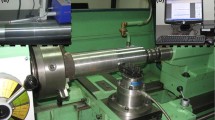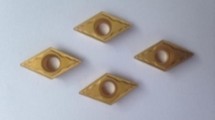Abstract
In the present study, an attempt has been made to investigate the effect of cutting parameters (cutting speed, feed and depth of cut) on machining forces (feed force, thrust force and cutting force) in finish hard turning of AISI 4340 steel using developed Zirconia Toughened Alumina (ZTA) insert prepared by powder metallurgy process route. The machining experiments were performed based on standard Response Surface Methodology (RSM) called Central Composite Design (CCD). The mathematical model of each forces have been developed using second order regression analysis. The adequacy of the models and influence of each operating factors have been carried out based on Analysis of Variance (ANOVA) techniques. It can be concluded from the present study that cutting speed and depth of cut have predominant effect on feed force whereas feed and depth of cut are the two most influencing factors for thrust force determination. But, in case of cutting force modeling, all the three parameters (feed rate, depth of cut and cutting speed) have significant effect. Key parameters and their effects on forces have also been presented in graphical contours which may help for choosing operating parameter preciously. Optimized model indicates 76.51% desirability level for economy in conventional machining process.
Similar content being viewed by others
References
Montgomery, D. C., “Design and Analysis of experiments, 5th Eds.,” New York, Wiley, 2007.
Lalwani, D. I., Mehta, N. K., and Jain, P. K., “Experimental investigations of cutting parameters influence on cutting forces and surface roughness in finish hard turning of MDN250 steel,” Journal of Materials Processing Technology, Vol. 206, No. 1–3, pp. 167–179, 2008.
Horng, J.-T., Liu, N.-M., and Chiang, K.-T., “Investigating the machinability evaluation of Hadfield steel in the hard turning with Al2O3/TiC mixed ceramic tool based on the response surface methodology,” Journal of Materials Processing Technology, Vol. 208, No. 1–3, pp. 532–541, 2008.
Ramanujam, R., Muthukrishnan, N., and Raju, R., “Optimization of cutting parameters for turning Al-SiC(10p) MMC using ANOVA and grey relational analysis,” Int. J. Precis. Eng. Manuf., Vol. 12, No. 4, pp. 651–656, 2011.
Chun, S. H. and Ko, T. J., “Study on the response surface model of machining error in internal lathe boring,” Int. J. Precis. Eng. Manuf., Vol. 12, No. 2, pp. 177–182, 2011.
Raju, K. M. V. K., Janardhana, R. G., Kumar, N. P., and Rao, V. P. D., “Optimization of cutting conditions for surface roughness in CNC end milling,” Int. J. Precis. Eng. Manuf., Vol. 12, No. 3, pp. 383–391, 2011.
Özel, T., Karpat, Y., Figueira, L., and Davim, J. P., “Modelling of surface finish and tool flank wear in turning of AISI D2 steel with ceramic wiper inserts,” Journal of Materials Processing Technology, Vol. 189, No. 1–3, pp. 192–198, 2007.
Dureja, J. S., Gupta, V. K., Sharma, V. S., and Dogra, M., “Design optimization of cutting conditions and analysis of their effect on tool wear and surface roughness during hard turning of AISI-H11 steel with a coated-mixed ceramic tool,” Journal of Engineering Manufacture, Vol. 223, No. 11, pp. 1441–1453, 2009.
Thangavel, P., Selladurai, V., and Shanmugam, R., “Application of response surface methodology for predicting flank wear in turning operation,” Journal of Engineering Manufacture, Vol. 220, No. 6, pp. 997–1003, 2006.
Huang, Y. and Liang, S. Y., “Effect of Cutting Conditions on Tool Performance in CBN Hard Turning,” Journal of Manufacturing Processes, Vol. 7, No. 1, pp. 10–16, 2005.
Amaitik, S. M., Tasgin, T. T., and Kilic, S. E., “Tool life modeling of carbide and ceramic cutting tools using multi linear regression analysis,” Journal of Engineering Manufacture, Vol. 220, No. 2, pp. 129–136, 2006.
Sahin, Y. and Motorcu, A. R., “Surface roughness model for machining mild steel with coated carbide tool,” Materials & Design, Vol. 26, No. 4, pp. 321–326, 2005.
Sahin, Y. and Motorcu, A. R., “Surface roughness model in machining hardened steel with cubic boron nitride cutting tool,” International Journal of Refractory Metals and Hard Materials, Vol. 26, No. 2, pp. 84–90, 2008.
Noordin, M. Y., Venkatesh, V. C., Sharif, S., Elting, S., and Abdullah, A., “Application of response surface methodology in describing the performance of coated carbide tools when turning AISI 1045 steel,” Journal of Materials Processing Technology, Vol. 145, No. 1, pp. 46–58, 2004.
Gaitonde, V. N., Karnik, S. R., Figueira, L., and Paulo Davim, J., “Machinability investigations in hard turning of AISI D2 cold work tool steel with conventional and wiper ceramic inserts,” International Journal of Refractory Metals and Hard Materials, Vol. 27, No. 4, pp. 754–763, 2009.
Gaitonde, V. N., Karnik, S. R., Figueira, L., and Paulo Davim, J., “Analysis of Machinability During Hard Turning of Cold Work Tool Steel (Type: AISI D2),” Journal of Materials & Manufacturing Processes, Vol. 24, No. 12, pp. 1373–1382, 2009.
Paulo Davim, J. and Figueira, L., “Comparative evaluation of conventional and wiper ceramic tools on cutting forces, surface roughness, and tool wear in hard turning AISI D2 steel,” Journal of Engineering Manufacture, Vol. 221, No. 4, pp. 625–633, 2007.
Paulo Davim, J. and Figueira, L., “Machinability evaluation in hard turning of cold work tool steel (D2) with ceramic tools using statistical techniques,” Materials & Design, Vol. 28, No. 4, pp. 1186–1191, 2007.
De Lima, J. G., De vila, R. F., and Abrão, A. M., “Turning of hardened AISI 4340 steel using coated carbide inserts,” Journal of Engineering Manufacture, Vol. 221, No. 8, pp. 1359–1366, 2007.
Sikdar, S. K. and Chen, M., “Relationship between tool flank wear area and component forces in single point turning,” Journal of Materials Processing Technology, Vol. 128, No. 1–3, pp. 210–215, 2002.
Dogra, M., Sharma, V., Sachdeva, A., Suri, N., and Dureja, J., “Performance evaluation of CBN, coated carbide, cryogenically treated uncoated/coated carbide inserts in finish-turning of hardened steel,” The International Journal of Advanced Manufacturing Technology, Vol. 57, No. 5–8, pp. 541–553, 2011.
Senthil Kumar, A., Raja Durai, A., and Sornakumar, T., “Development of alumina-ceria ceramic composite cutting tool,” International Journal of Refractory Metals and Hard Materials, Vol. 22, No. 1, pp. 17–20, 2004.
Senthil Kumar, A., Raja Durai, A., and Sornakumar, T., “Machinability of hardened steel using alumina based ceramic cutting tools,” International Journal of Refractory Metals and Hard Materials, Vol. 21, No. 3–4, pp. 109–117, 2003.
Mandal, N., Doloi, B., and Mondal, B., “Development of flank wear prediction model of Zirconia Toughened Alumina (ZTA) cutting tool using response surface methodology,” International Journal of Refractory Metals and Hard Materials, Vol. 29, No. 2, pp. 273–280, 2011.
Mondal, B., “Zirconia toughened alumina for wear resistant engineering and machinability of steel application,” Advances in Applied Ceramics, Vol. 104, No. 5, pp. 256–260, 2005.
Senthil Kumar, A., Raja Durai, A., and Sornakumar, T., “Development of yttria and ceria toughened alumina composite for cutting tool application,” International Journal of Refractory Metals and Hard Materials, Vol. 25, No. 3, pp. 214–219, 2007.
Dutta, A. K., Chattopadhyaya, A. B., and Ray, K. K., “Progressive flank wear and machining performance of silver toughened alumina cutting tool inserts,” Wear, Vol. 261, No. 7–8, pp. 885–895, 2006.
Mondal, B., “Development and Performance of aluminazirconia cutting tool inserts,” Ph.D. Thesis, IIT Kharagpur, India, 1989.
Claussen, N., “Stress-induced transformation of tetragonal ZrO2 particles in ceramic matrices,” Journal of American Ceramic Society, Vol. 61, No. 1–2, pp. 85–86, 1978.
Lange, F. F., “Transformation toughening, Part I–Part 5,” Journal of Materials Science, Vol. 17, No. 1, pp. 225–263, 1982.
Author information
Authors and Affiliations
Corresponding author
Rights and permissions
About this article
Cite this article
Mandal, N., Doloi, B. & Mondal, B. Force prediction model of Zirconia Toughened Alumina (ZTA) inserts in hard turning of AISI 4340 steel using response surface methodology. Int. J. Precis. Eng. Manuf. 13, 1589–1599 (2012). https://doi.org/10.1007/s12541-012-0209-x
Received:
Accepted:
Published:
Issue Date:
DOI: https://doi.org/10.1007/s12541-012-0209-x




